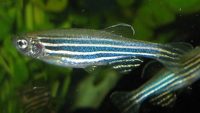In order to have evolution, you must first have life. Both sides of the evolution-creation debate agree that the chance of all the correct biomolecules coming together by chance to form even the simplest cell is virtually impossible. Fred Hoyle1 (an atheist) estimated the probability as one chance in 1040,000. He compared the likelihood of life originating on Earth to that of a tornado going through a junkyard and assembling… More… …read more Source: icr.org
By Perry McDorman How God gifted the strawberry poison dart frogs in Central America to care for their young pollywogs from hatching until their metamorphosis is complete …read more Source: AIG Daily
Ever had a blood test? Along with a value measured, there are also the normal max/min limits for that value. This implies that the body normally controls that quantity between those limits. How does it do that? It measures the value and produces more or less of that quantity based on the value measured. This is called a control loop. There are hundreds of thousands, perhaps millions, of control loops in the human body.More… …read more Source: icr.org
A recent study published in Science claims that an asteroid caused new forms of plants to evolve.1-3 But can an asteroid really be responsible for selecting new forms of life? Mónica Carvalho of the Smithsonian Tropical Research Institute, Panama and her colleagues studied fossil pollen and leaves from Colombia that spanned the K-Pg (Cretaceous-Paleogene) boundary.1 They concluded that plant di… More… …read more Source: icr.org
By Dr. Nathaniel T. Jeanson Creation science is quietly making groundbreaking discoveries. …read more Source: AIG Daily
By Dr. Marcus Ross When you think of the Ice Age, you think of big critters like the woolly mammoth and giant sloth. Why was this huge size so helpful? …read more Source: AIG Daily
Supports rapid plant growth after the Flood …read more Source: creation.com
By Dr. Gordon Wilson The most diverse order of animals on the planet is by far the beetle order. God shows how He can take one design and create a spectacular array of forms. …read more Source: AIG Daily
By Tom Hennigan Did the Creator foresee the biological resources we would need to help correct our mistakes, as we fulfill His command to “subdue the earth”? …read more Source: AIG Daily
The first rough drafts of the human genome were reported in 2001 (one in the private sector and one in the public sector).1-2 Since then, after 20 years of intensive globally conducted research, the data has revealed a wealth of complexity that has completely upset all of the original evolutionary misconceptions.3 Most importantly, the false evolutionary paradigm of “junk DNA” has been utterly debunked in favor o… More… …read more Source: icr.org
By Ken Ham From reading Genesis, and armed with a basic knowledge of genetics, we can learn a lot about what Adam was probably like. …read more Source: AIG Daily
Scientists once again have claimed to created artificial living cells? What does this really mean for chemical evolution? …read more Source: creation.com
These clever, ingeniously-designed creatures point to the Creator. …read more Source: creation.com
Multiple pieces of evidence support the idea of genetic entropy, but if it is true there is no hope for the human race outside of the second coming of Jesus Christ. …read more Source: creation.com
By Dr. Elizabeth Mitchell Cambridge researchers discovered functioning mechanical gears in juvenile leafhoppers as “training wheels,” showing that God created gears long before humans. …read more Source: AIG Daily
By Harry F. Sanders, III How zebrafish mutation guides species to extinction instead of theoretical improvement, despite evolutionary propaganda attempts …read more Source: AIG Daily
Humans are born with brains ‘prewired’ to see words. How can evolutionists explain this? …read more Source: creation.com
Both evolutionists and creationists are claiming the Glasswing Butterfly as their own. Who’s right? …read more Source: creation.com
Researchers have found a dimmer switch inside a protein. It tunes the protein’s configuration to take advantage of quantum mechanics during photosynthesis. Two parallels with human engineering leave no doubts about the engineered origins of this light collector. University of Chicago scientists found an elegant sensor connected to the dimmer switch. Two critical chemical parts of the protein together act “as a trigger,&… More… …read more Source: icr.org
By Ken Ham The appendix—“a useless artifact of evolution”? We’ve heard that old, debunked claim over and over (and over!) again. I was taught this false claim when I went to university in the 1970s. Well, a recent article contained a thought experiment about what life might be like if this organ had never “evolved”—and they concluded that “you’d see a lot more people dying of infectious diseases than they would otherwise.” Why? Well, because the appendix is far from a useless vestige of our imaginary evolutionary ancestry! While, of course, you can live without it, it’s a very useful [More]
Is the bird order Caprimulgiformes a single created kind? …read more Source: creation.com
The evolutionary hype around this month’s celebrations of the 150th anniversary of the publication of Darwin’s Origin of Species ignores a key problem that even Darwin acknowledged. …read more Source: creation.com
The esteemed presenter of memorable nature documentaries has a standard answer when asked about a creator. …read more Source: creation.com
By Karina Altman Their ability to regenerate makes these salamanders the closest thing to the fountain of youth found in nature. …read more Source: AIG Daily
Humans have the remarkable ability to inhabit high altitudes where living conditions are especially harsh and challenging. A new study in Genome Biology and Evolution has shown that specifically directed epigenetic modifications to various places in the genome are an important heritable adaptive mechanism in conferring this unique ability.1 These new results utterly refute the false Darwinian paradigm of natural selection&mdas… More… …read more Source: icr.org
By Avery Foley Upon closer examination, this popular evolutionary argument quickly comes undone. …read more Source: AIG Daily

















![Old Friends [Live] Old Friends [Live]](http://img.youtube.com/vi/rrqpQBqj_qs/0.jpg)



























